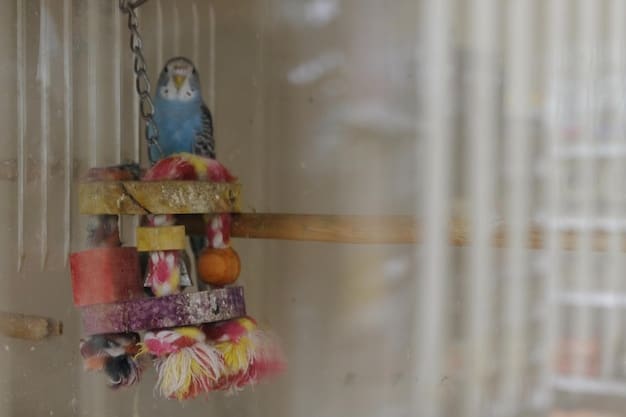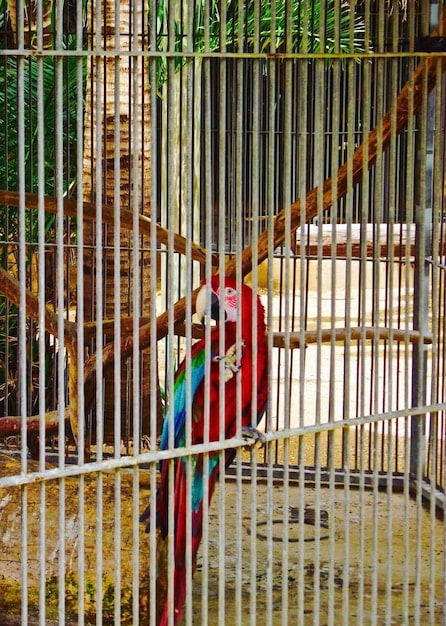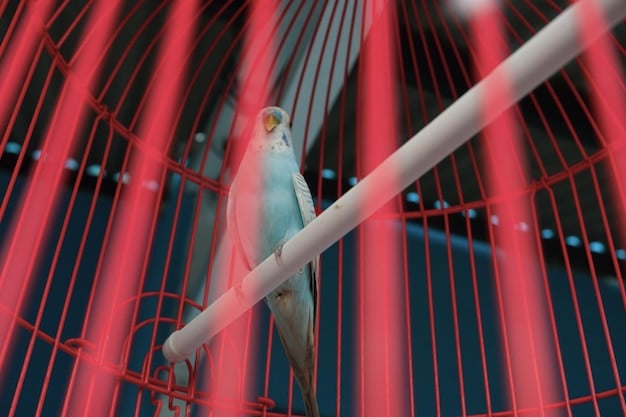Bird Cage Reviews: Find the Perfect Home for Your Feathered Friend in 2025

Bird Cage Reviews for 2025 focus on providing a safe, comfortable, and stimulating environment for pet birds. This guide examines key features, materials, and sizes to help you select the ideal cage, ensuring your feathered friend thrives in its new home.
Choosing the right bird cage is crucial for your feathered friend’s well-being. Our bird cage reviews: finding the right home for your feathered friend in 2025, will guide you through the essential features, materials, and sizes, ensuring a happy and healthy environment for your pet.
Choosing the Right Bird Cage: An Overview
Selecting a bird cage involves several important considerations. A well-chosen cage provides security, comfort, and opportunities for enrichment, significantly impacting your bird’s physical and mental health. Let’s delve into what makes a good bird cage.
Cage Size and Bird Species
The size of the cage is paramount and depends on the species of bird you own. Smaller birds, like finches and canaries, require less space than larger birds such as parrots and macaws.
- Finches and Canaries: These birds need cages that allow them to fly horizontally. A minimum of 24 inches in length is recommended.
- Parakeets and Cockatiels: These birds require more vertical space. A cage that is at least 18 inches wide, 18 inches deep, and 24 inches high is suitable.
- Parrots and Macaws: These large birds need substantial space. Cages should be a minimum of 36 inches wide, 24 inches deep, and 48 inches high.
Adequate space allows birds to stretch their wings, engage in natural behaviors, and avoid stress-related issues. Ensure that the cage you select provides enough room for your bird to move freely and comfortably.
Essential Features of a Bird Cage
Beyond size, several features contribute to the suitability of a bird cage. These include bar spacing, material, and ease of cleaning. Each element plays a role in your bird’s safety and comfort.

Bar Spacing and Safety
Bar spacing is crucial in preventing escapes and injuries. The spacing should be narrow enough to prevent your bird from squeezing through, but wide enough to avoid trapping their head or feet.
- Small Birds (Finches, Canaries): Bar spacing should be no more than 1/2 inch.
- Medium Birds (Parakeets, Cockatiels): Bar spacing should be between 1/2 inch and 5/8 inch.
- Large Birds (Parrots, Macaws): Bar spacing should be between 3/4 inch and 1 inch.
Regularly inspect the bar spacing to ensure it remains consistent and safe, especially if the cage is old or has been damaged.
Material and Durability
The material of the bird cage affects its durability and safety. Common materials include stainless steel, wrought iron, and powder-coated metal.
Stainless steel cages are the most durable and safest option, as they are non-toxic and resistant to rust. Wrought iron cages are sturdy but may rust if not properly maintained. Powder-coated metal cages are a more affordable option but can chip or scratch, exposing the metal underneath, which may be toxic.
Choose a material that is durable, non-toxic, and easy to clean. Avoid cages with lead or zinc, as these can be harmful if ingested.
Considering Cage Design and Structure
The design and structure of a bird cage impact its functionality and aesthetics. Opting for cages with horizontal bars to facilitate climbing for many bird species ensures enrichment and exercise throughout their daily routines
Shape Matters
The shape of the cage also contributes to your bird’s comfort. Rectangular or square cages are generally preferred, as they provide more usable space compared to round cages. Round cages can also cause psychological distress, as birds may feel disoriented without corners to provide a sense of security.
Placement and Stability
Consider where you will place the cage. Ensure it is on a stable surface, away from direct sunlight, drafts, and high-traffic areas. A cage stand with wheels can make it easier to move the cage for cleaning or to different locations within your home.

By considering these design and structural elements, you can create a safe and comfortable environment for your feathered friend.
Enhancing the Cage Environment
A bare cage is inadequate for a bird’s well-being. Enhancing the cage environment with perches, toys, and food bowls is essential for providing mental and physical stimulation.
What goes inside can make a difference.
Perches: Variety is Key
Perches are critical for your bird’s foot health. Provide a variety of perches in different sizes, shapes, and materials. Natural wood perches, such as those made from apple or willow branches, mimic a bird’s natural environment and help keep their nails trimmed.
Avoid using only plastic perches, as these can cause foot problems and don’t provide the same level of comfort. Place perches at different heights to encourage climbing and exploration ensuring there’s enough room.
Toys: Mental Stimulation
Toys are essential for preventing boredom and promoting mental stimulation. Birds are intelligent creatures and need activities to keep them engaged, or they can lead to destructive habits.
- Foraging Toys: These toys require birds to work for their food, mimicking natural foraging behaviors.
- Shredding Toys: Birds enjoy tearing apart paper, cardboard, and soft wood.
- Puzzle Toys: These toys challenge birds to solve problems to get a treat.
Rotate toys regularly to keep your bird interested and prevent them from becoming bored.
Maintenance and Cleaning of Bird Cages
Regular maintenance and cleaning are essential for keeping your bird’s cage hygienic and preventing the spread of disease. A clean cage contributes to your bird’s overall health and well-being that results in good long term bird living.
Daily Cleaning Tasks
Daily cleaning involves removing droppings, uneaten food, and other debris from the bottom of the cage. Line the bottom of the cage with newspaper or paper towels for easy cleanup. Replace the lining daily to maintain a clean environment.
Weekly Deep Cleaning
Weekly deep cleaning involves washing the entire cage with warm, soapy water. Remove all perches, toys, and food bowls, and scrub them thoroughly. Rinse the cage and accessories well and allow them to dry completely before reassembling.
Use a bird-safe disinfectant to kill any bacteria or germs. Avoid using harsh chemicals or cleaners that could be harmful to your bird.
Preventing Common Problems
Regular cleaning can prevent common problems such as mites, parasites, and bacterial infections. Inspect the cage regularly for signs of damage or wear, and repair or replace as needed.
Top Bird Cage Brands and Models for 2025
Several reputable brands offer high-quality bird cages designed for various bird species. Researching and choosing a trusted brand can ensure you get a durable and safe cage. Let’s explore brands.
Prevue Pet Products
Prevue Pet Products offers a wide range of bird cages known for their durability and functionality. Their cages come in various sizes and styles, suitable for finches to macaws. Look for features such as powder-coated finishes, removable trays, and easy-access doors.
Vision Bird Cages
Vision Bird Cages are designed to minimize mess and make cleaning easier. These cages feature a deep base to contain seed and droppings, reducing the amount of debris that falls outside the cage. They are available in various sizes and are suitable for small to medium-sized birds.
Yaheetech Bird Cages
Yaheetech Bird Cages are a budget-friendly option that doesn’t compromise on quality. These cages are made from durable materials and feature multiple perches, food bowls, and removable trays for easy cleaning. They are available in various sizes and styles to suit different bird species.
| Key Point | Brief Description |
|---|---|
| 📏 Cage Size | Choose a cage size appropriate for your bird species to allow free movement. |
| 🔒 Bar Spacing | Ensure bar spacing is safe to prevent escapes or injuries. |
| 🛠️ Cage Material | Opt for durable, non-toxic materials like stainless steel. |
| 🧼 Maintenance | Clean the cage regularly to ensure hygiene and prevent diseases. |
FAQ Section
▼
The cage size depends on the bird species. Small birds need at least 24 inches in length, while larger birds may require cages that are 36 inches wide, 24 inches deep, and 48 inches high.
▼
Daily, remove droppings and uneaten food. Weekly, perform a deep clean with warm, soapy water. This maintains a hygienic environment and prevents the spread of disease within the cage.
▼
Stainless steel is safest, being non-toxic and rust-resistant. Wrought iron is sturdy but needs maintenance. Avoid cages with lead or zinc as they can be harmful if ingested by the bird.
▼
Provide a variety of toys such as foraging toys, shredding toys, and puzzle toys. Rotate them regularly to keep your bird interested and engaged. Lack of stimulation can lead to destructive habits.
▼
Variety is key. Use natural wood perches, like apple or willow, to mimic a bird’s natural environment, plus keep nails trimmed. Avoid plastic perches as they can cause foot problems for birds.
Conclusion
Selecting the perfect bird cage involves careful consideration of size, materials, design, and enhancements. By prioritizing your bird’s safety, comfort, and mental stimulation, you can create a thriving environment that supports their overall well-being. The bird cage reviews: finding the right home for your feathered friend in 2025, it’s about informed decisions for happier, healthier birds.





